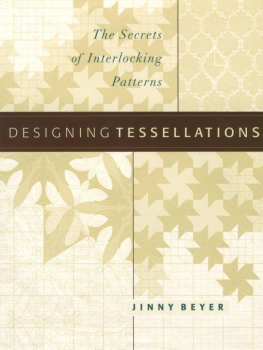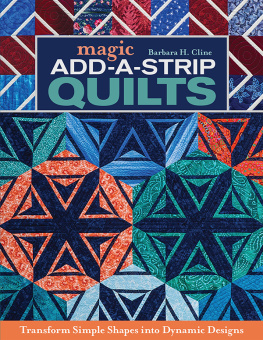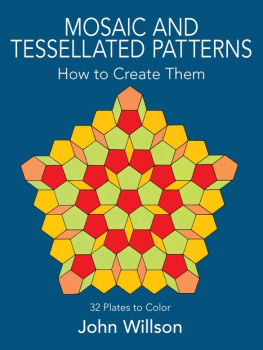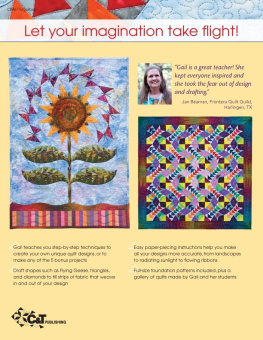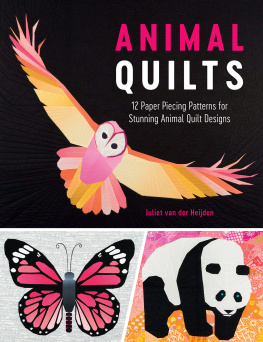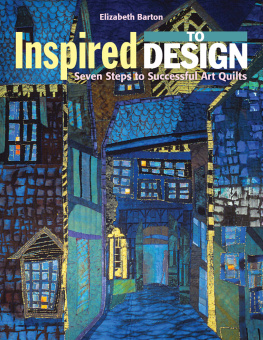Table of Contents
Library of Congress Cataloging-in-Publication Data
Beyer, Jinny.
Designing tessellations : the secrets of interlocking patterns / Jinny Beyer.
p. cm.
Includes bibliographical references.
ISBN 0-8092-2866-1
1. Quilting. 2. Patchwork. 3. QuiltsDesign. 4. Patchwork quilts
Design. I. Title.
TT835.B429 1998
746.46041dc21
98-13128
CIP
Editorial and production direction by Anne Knudsen
Art direction and interior design by Kim Bartko
Cover design by Monica Baziuk
interior layouts by Mary C. Lockwood
Production editing by Michelle Davidson
Technical drawings by Kandy Petersen
Manufacturing direction by Pat Martin
Quilt photography by Steve Tuttle, unless specifically credited
Picture research by Elizabeth Broadrup Lieberman
Published by Contemporary Books
A division of NTC/Contemporary Publishing Group, Inc.
4255 West Touhy Avenue, Lincolnwood (Chicago), Illinois 60646-1975 U.S.A.
Copyright 1999 by Jinny Beyer
All rights reserved. No part of this book may be reproduced, stored in a retrieval system, or transmitted in any form or by any means, electronic, mechanical, photocopying, recording, or otherwise, without the prior written permission of NTC/Contemporary Publishing Group, Inc.
Printed in Singapore
International Standard Book Number: 0-8092-2866-1
00 01 02 03 04 SS 20 19 18 17 16 15 14 13 12 11 10 9 8 7 6 5 4 3
To the memory of M. C. Escher. His genius for creating intricate
interlocking patterns has delighted artists and artisans for decades.
His work inspired me on the quest for discovery and
experimentation that resulted in Designing Tessellations.
American Woven Coverlet
Introduction
Geometric design has been an integral part of my life for the last 25 years. During that time I have often wondered why it was that I almost flunked high school geometry. The class was drudgery and so very difficult that I gave up taking further math courses. Yet as an adult, when I first became interested in surface design, it was geometric patterns that intrigued me more than any others.
Shortly after we were married, my husband and I lived for several years in various countries in the Orient. I was intrigued by the incredibly beautiful geometric designs that adorned the walls, floors, and windows of the palaces, temples, mosques, and shrines we visited. The structure and the repeat of those patterns across a surface fascinated me. I wanted to know how those designs were created and to be able to reproduce them myself.
My interest in design has followed many courses, but it was shortly after our return from the Orient in the early 1970s that I began exploring the world of geometric patterns in earnest, and that was in the field of quilt making. The block motifs of the quilts themselves inspired me, but I was equally excited by seeing how those patterns changed as various symmetrical arrangements were applied to them. My love of geometric patterns continued as my career progressed into textile design. It is a constant challenge to figure out how various designs are made and how to make new ones. I also get immense enjoyment from showing others how easy it is to design, create, and draft geometric designs for use in any area of surface design.
That high school geometry class was difficult because it was no fun. All we did was memorize formulas and do equations. Much later, I learned with excitement the versatility of geometric motifs in pattern design. I was sorry that my teacher had not applied the geometric lessons to more concrete examples and that my mind had not been ready to absorb the information.
Tessellations
One of the first tessellated designs I saw more than 20 years ago was the popular quilt pattern known as Spool or Indian Hatchet. Without knowing it was a tessellation, the design appealed to me immediately. I set about to recreate it. My attempts at first frustrated me. Then, with delight, I noticed how the curves in the pattern fit together, one into the next, flowing smoothly across the surface. I was hooked.
Modified Spool, antique charm quilt, quilter unknown, c. 1880.
When I found a book on M. C. Eschers work I was enthralled yet mystified. His graphic designs relied on incredibly complicated interlocking patterns and designs. Sometimes more than one image joined with another. It was beyond me how those patterns were created, and the books written on the subject reminded me of that high school geometry class; the terminology and explanations were over my head.
I knew one day I would take the time to study and try to figure it all out. That time came almost six years ago. Working on it ever since, I have made the most incredible journey; a journey that has flung open a door to new design opportunities; a journey that has led to an understanding of symmetry in nature and surface design; and a journey that has given me the key to unlock the mysteries of Eschers art that had seemed so out of reach. Once the lightbulbs started going on, it became so simple. In Designing Tessellations, I want to share my experiences and discoveries, and make it easier for others to work with tessellating designs.
Symmetry and Tessellations Intertwined
Tessellations and symmetry go hand in hand. A knowledge of symmetrical design is essential for full comprehension of tessellations. And, once an understanding of tessellations has been achieved, the numerous applications of symmetry to tessellated designs makes them even more exciting.
Kashmir Shawl
Escher studied the theory of tessellating designs extensively. He developed his own classification system for creating and defining tessellating motifs. Crystallographers and mathematicians have explained the theories in mathematical terms, but to the layperson who docs not have advanced mathematical degrees the terminology and explanations can seem daunting.
As I studied Escher and experimented with tessellating motifs, I worked out the system that seemed to make the most sense to me. I present my own system here, in hopes that I will not offend the mathematicians, but with a desire to share my knowledge with others who, like me, want to understand the basics of creating tessellating design, but who may not have studied math. This book is for you, so you do not have to struggle as I did or wade through formulas or give up in frustration. It is not enough for me just to tell you what to do; it is important for you to understand what you are doing and what you hope to achieve. Once that understanding takes place, there is freedom for experimentation and creativity that is uniquely rewarding.
Birds and Fish
by Jinny Beyer.
Because of the interrelationship between symmetry and tessellations this book will first explore the wonders of linear and two-dimensional symmetry and will then lead you into the exciting world of tessellations.

